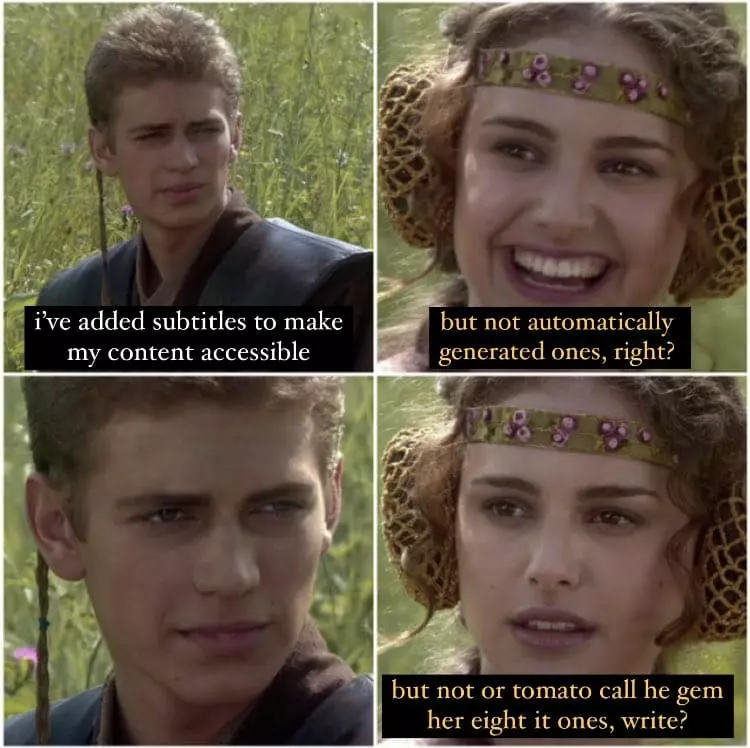
ಆಟೋಕ್ಯಾಪ್ಷನಿಂಗ್ ತಂತ್ರಜ್ಞಾನ ಹೇಗೆ ಕೆಲಸ ಮಾಡುತ್ತದೆ?
ಡಿಜಿಟಲ್ ಯುಗದಲ್ಲಿ, ಆಟೋಕ್ಯಾಪ್ಷನಿಂಗ್ ವೀಡಿಯೊ ವಿಷಯದ ಅವಿಭಾಜ್ಯ ಅಂಗವಾಗಿದೆ. ಇದು ವೀಕ್ಷಕರ ಗ್ರಹಿಕೆಯ ಅನುಭವವನ್ನು ಹೆಚ್ಚಿಸುವುದಲ್ಲದೆ, ಪ್ರವೇಶಸಾಧ್ಯತೆ ಮತ್ತು ಅಂತರರಾಷ್ಟ್ರೀಯ ಪ್ರಸರಣಕ್ಕೂ ನಿರ್ಣಾಯಕವಾಗಿದೆ.
ಆದರೂ ಒಂದು ಪ್ರಮುಖ ಪ್ರಶ್ನೆ ಉಳಿದಿದೆ: “ಸ್ವಯಂ ಶೀರ್ಷಿಕೆ ಎಷ್ಟು ನಿಖರವಾಗಿದೆ?” ಶೀರ್ಷಿಕೆಗಳ ನಿಖರತೆಯು ಮಾಹಿತಿಯ ವಿಶ್ವಾಸಾರ್ಹತೆ ಮತ್ತು ಅದರ ಪ್ರಸರಣದ ಪರಿಣಾಮಕಾರಿತ್ವದ ಮೇಲೆ ನೇರವಾಗಿ ಪರಿಣಾಮ ಬೀರುತ್ತದೆ. ಈ ಲೇಖನವು ಇತ್ತೀಚಿನ ಭಾಷಣ ಗುರುತಿಸುವಿಕೆ ತಂತ್ರಜ್ಞಾನಗಳು, ವಿವಿಧ ವೇದಿಕೆಗಳಲ್ಲಿ ತುಲನಾತ್ಮಕ ಡೇಟಾ ಮತ್ತು ಬಳಕೆದಾರರ ಅನುಭವಗಳನ್ನು ಪರಿಶೀಲಿಸುವ ಮೂಲಕ ಸ್ವಯಂ ಶೀರ್ಷಿಕೆಯ ನಿಜವಾದ ಕಾರ್ಯಕ್ಷಮತೆಯನ್ನು ಅನ್ವೇಷಿಸುತ್ತದೆ. ಶೀರ್ಷಿಕೆ ಗುಣಮಟ್ಟವನ್ನು ಹೆಚ್ಚಿಸುವಲ್ಲಿ ನಾವು Easysub ನ ವೃತ್ತಿಪರ ಪರಿಣತಿಯನ್ನು ಸಹ ಹಂಚಿಕೊಳ್ಳುತ್ತೇವೆ.
"ಸ್ವಯಂ ಶೀರ್ಷಿಕೆ ಎಷ್ಟು ನಿಖರವಾಗಿದೆ?" ಎಂಬುದನ್ನು ಅರ್ಥಮಾಡಿಕೊಳ್ಳಲು, ಮೊದಲು ಅರ್ಥಮಾಡಿಕೊಳ್ಳಬೇಕು ಸ್ವಯಂಚಾಲಿತ ಶೀರ್ಷಿಕೆಗಳನ್ನು ಹೇಗೆ ರಚಿಸಲಾಗುತ್ತದೆ. ಆಟೋಕ್ಯಾಪ್ಷನಿಂಗ್ ಅದರ ಮೂಲದಲ್ಲಿ, ಸ್ವಯಂಚಾಲಿತ ಭಾಷಣ ಗುರುತಿಸುವಿಕೆ (ASR) ತಂತ್ರಜ್ಞಾನವನ್ನು ಅವಲಂಬಿಸಿದೆ, ಇದು ಕೃತಕ ಬುದ್ಧಿಮತ್ತೆ ಮತ್ತು ನೈಸರ್ಗಿಕ ಭಾಷಾ ಸಂಸ್ಕರಣಾ ಮಾದರಿಗಳನ್ನು ಬಳಸುತ್ತದೆ ಮಾತನಾಡುವ ವಿಷಯವನ್ನು ಪಠ್ಯವಾಗಿ ಪರಿವರ್ತಿಸಿ.
ಉಪಶೀರ್ಷಿಕೆ ಉತ್ಪಾದನೆ ಮತ್ತು ಆಪ್ಟಿಮೈಸೇಶನ್ನಲ್ಲಿ ಪರಿಣತಿ ಹೊಂದಿರುವ ಬ್ರ್ಯಾಂಡ್ ಆಗಿ, ಈಸಿಸಬ್ ಪ್ರಾಯೋಗಿಕ ಅನ್ವಯಿಕೆಗಳಲ್ಲಿ ಆಳವಾದ ಕಲಿಕೆ ಮತ್ತು ನಂತರದ ಸಂಸ್ಕರಣಾ ಕಾರ್ಯವಿಧಾನಗಳನ್ನು ಸಂಯೋಜಿಸುತ್ತದೆ, ದೋಷಗಳನ್ನು ಸ್ವಲ್ಪ ಮಟ್ಟಿಗೆ ಕಡಿಮೆ ಮಾಡುತ್ತದೆ, ಬಳಕೆದಾರರಿಗೆ ಉತ್ತಮ ಗುಣಮಟ್ಟದ ಉಪಶೀರ್ಷಿಕೆ ಪರಿಹಾರಗಳನ್ನು ಒದಗಿಸುತ್ತದೆ.
"ಸ್ವಯಂ ಶೀರ್ಷಿಕೆ ಎಷ್ಟು ನಿಖರವಾಗಿದೆ?" ಎಂದು ಚರ್ಚಿಸುವಾಗ, ನಮಗೆ ವೈಜ್ಞಾನಿಕ ಅಳತೆ ಮಾನದಂಡಗಳ ಅಗತ್ಯವಿದೆ. ಶೀರ್ಷಿಕೆಗಳ ನಿಖರತೆಯು ಕೇವಲ "ಅವು ಎಷ್ಟು ಹತ್ತಿರದಲ್ಲಿವೆ" ಎಂಬುದರ ಬಗ್ಗೆ ಅಲ್ಲ, ಬದಲಿಗೆ ಸ್ಪಷ್ಟ ಮೌಲ್ಯಮಾಪನ ವಿಧಾನಗಳು ಮತ್ತು ಮೆಟ್ರಿಕ್ಗಳನ್ನು ಒಳಗೊಂಡಿರುತ್ತದೆ.
ಇದು ಅತ್ಯಂತ ಸಾಮಾನ್ಯವಾಗಿ ಬಳಸುವ ಮೆಟ್ರಿಕ್ ಆಗಿದ್ದು, ಇದನ್ನು ಈ ಕೆಳಗಿನಂತೆ ಲೆಕ್ಕಹಾಕಲಾಗುತ್ತದೆ:
WER = (ಬದಲಿ ಎಣಿಕೆ + ಅಳಿಸುವಿಕೆ ಎಣಿಕೆ + ಅಳವಡಿಕೆ ಎಣಿಕೆ)/ಒಟ್ಟು ಪದಗಳ ಎಣಿಕೆ
ಉದಾಹರಣೆಗೆ:
ಇಲ್ಲಿ, "" ಅನ್ನು ಬದಲಾಯಿಸಲಾಗುತ್ತಿದೆ.“ಪ್ರೀತಿ”" ಜೊತೆಗೆ "“ಇಷ್ಟ” ಒಂದು ತಪ್ಪಾದ ಪರ್ಯಾಯವನ್ನು ರೂಪಿಸುತ್ತದೆ.
ವಾಕ್ಯ ಮಟ್ಟದಲ್ಲಿ ಅಳೆಯಲಾಗುತ್ತದೆ, ಅಲ್ಲಿ ಉಪಶೀರ್ಷಿಕೆಯಲ್ಲಿನ ಯಾವುದೇ ದೋಷವನ್ನು ಸಂಪೂರ್ಣ ವಾಕ್ಯ ದೋಷವೆಂದು ಪರಿಗಣಿಸಲಾಗುತ್ತದೆ. ಈ ಕಠಿಣ ಮಾನದಂಡವನ್ನು ಸಾಮಾನ್ಯವಾಗಿ ವೃತ್ತಿಪರ ಸಂದರ್ಭಗಳಲ್ಲಿ ಬಳಸಲಾಗುತ್ತದೆ (ಉದಾ, ಕಾನೂನು ಅಥವಾ ವೈದ್ಯಕೀಯ ಉಪಶೀರ್ಷಿಕೆ).
ಚೈನೀಸ್ ಮತ್ತು ಜಪಾನೀಸ್ ನಂತಹ ಫೋನೆಟಿಕ್ ಅಲ್ಲದ ಭಾಷೆಗಳಲ್ಲಿ ನಿಖರತೆಯನ್ನು ಮೌಲ್ಯಮಾಪನ ಮಾಡಲು ವಿಶೇಷವಾಗಿ ಸೂಕ್ತವಾಗಿದೆ. ಇದರ ಲೆಕ್ಕಾಚಾರದ ವಿಧಾನವು WER ಅನ್ನು ಹೋಲುತ್ತದೆ, ಆದರೆ "ಅಕ್ಷರಗಳನ್ನು" ಮೂಲ ಘಟಕವಾಗಿ ಬಳಸುತ್ತದೆ.
ಉದಾಹರಣೆಗೆ:
WER ದೋಷವನ್ನು ಸೂಚಿಸಿದರೂ, ವೀಕ್ಷಕರು ಇನ್ನೂ ಅರ್ಥವನ್ನು ಗ್ರಹಿಸಬಹುದು, ಆದ್ದರಿಂದ ಈ ಸಂದರ್ಭದಲ್ಲಿ "ಗ್ರಹಿಕೆ" ಹೆಚ್ಚಾಗಿರುತ್ತದೆ.
ಉದ್ಯಮದೊಳಗೆ, ಒಂದು 95% WER ನಿಖರತೆ ದರ ತುಲನಾತ್ಮಕವಾಗಿ ಹೆಚ್ಚು ಎಂದು ಪರಿಗಣಿಸಲಾಗಿದೆ. ಆದಾಗ್ಯೂ, ಕಾನೂನು, ಶೈಕ್ಷಣಿಕ ಮತ್ತು ವೃತ್ತಿಪರ ಮಾಧ್ಯಮ ಸಂದರ್ಭಗಳಂತಹ ಸನ್ನಿವೇಶಗಳಿಗೆ, ಒಂದು ನಿಖರತೆಯ ದರ 99% ಸಮೀಪಿಸುತ್ತಿದೆ ಬೇಡಿಕೆಗಳನ್ನು ಪೂರೈಸಲು ಆಗಾಗ್ಗೆ ಅಗತ್ಯವಿರುತ್ತದೆ.
ಹೋಲಿಸಿದರೆ, YouTube ನ ಸ್ವಯಂಚಾಲಿತ ಶೀರ್ಷಿಕೆಗಳಂತಹ ಸಾಮಾನ್ಯ ವೇದಿಕೆಗಳು ನಿಖರತೆಯ ದರಗಳನ್ನು ಸಾಧಿಸುತ್ತವೆ. 60% ಮತ್ತು 90% ನಡುವೆ, ಆಡಿಯೋ ಗುಣಮಟ್ಟ ಮತ್ತು ಮಾತನಾಡುವ ಪರಿಸ್ಥಿತಿಗಳನ್ನು ಅವಲಂಬಿಸಿರುತ್ತದೆ. ವೃತ್ತಿಪರ ಪರಿಕರಗಳಾದ ಈಸಿಸಬ್, ಆದಾಗ್ಯೂ, ಸ್ವಯಂಚಾಲಿತ ಗುರುತಿಸುವಿಕೆಯ ನಂತರ AI ಆಪ್ಟಿಮೈಸೇಶನ್ ಅನ್ನು ನಂತರದ ಸಂಪಾದನೆಯೊಂದಿಗೆ ಸಂಯೋಜಿಸಿ, ದೋಷ ದರಗಳನ್ನು ಗಮನಾರ್ಹವಾಗಿ ಕಡಿಮೆ ಮಾಡುತ್ತದೆ.
"ಸ್ವಯಂ ಶೀರ್ಷಿಕೆ ಎಷ್ಟು ನಿಖರವಾಗಿದೆ?" ಎಂಬ ಪ್ರಶ್ನೆಗೆ ಉತ್ತರಿಸುವಾಗ, ಶೀರ್ಷಿಕೆಗಳ ನಿಖರತೆಯು ತಂತ್ರಜ್ಞಾನವನ್ನು ಮೀರಿದ ಬಹು ಬಾಹ್ಯ ಅಂಶಗಳಿಂದ ಪ್ರಭಾವಿತವಾಗಿರುತ್ತದೆ. ಅತ್ಯಂತ ಮುಂದುವರಿದ AI ಭಾಷಣ ಗುರುತಿಸುವಿಕೆ ಮಾದರಿಗಳು ಸಹ ವಿಭಿನ್ನ ಪರಿಸರಗಳಲ್ಲಿ ಕಾರ್ಯಕ್ಷಮತೆಯಲ್ಲಿ ಗಮನಾರ್ಹ ವ್ಯತ್ಯಾಸಗಳನ್ನು ಪ್ರದರ್ಶಿಸುತ್ತವೆ. ಪ್ರಾಥಮಿಕ ಪ್ರಭಾವ ಬೀರುವ ಅಂಶಗಳು ಈ ಕೆಳಗಿನಂತಿವೆ:
ಪ್ಲಾಟ್ಫಾರ್ಮ್-ಎಂಬೆಡೆಡ್ ಉಪಶೀರ್ಷಿಕೆಗಳು (ಉದಾ, YouTube, Zoom, TikTok) ಸಾಮಾನ್ಯವಾಗಿ ದೈನಂದಿನ ಬಳಕೆಗೆ ಸೂಕ್ತವಾದ ಸಾರ್ವತ್ರಿಕ ಮಾದರಿಗಳನ್ನು ಅವಲಂಬಿಸಿವೆ, ಆದರೆ ಅವುಗಳ ನಿಖರತೆಯು ಅಸಮಂಜಸವಾಗಿಯೇ ಉಳಿದಿದೆ.
ವೃತ್ತಿಪರ ಉಪಶೀರ್ಷಿಕೆ ಪರಿಕರಗಳು (ಉದಾ., ಈಸಿಸಬ್) ಸಂಸ್ಕರಣಾ ನಂತರದ ಆಪ್ಟಿಮೈಸೇಶನ್ ಅನ್ನು ಗುರುತಿಸುವಿಕೆಯ ನಂತರ ಮಾನವ ಪ್ರೂಫ್ ರೀಡಿಂಗ್ನೊಂದಿಗೆ ಸಂಯೋಜಿಸಿ, ಗದ್ದಲದ ಪರಿಸರಗಳು ಮತ್ತು ಸಂಕೀರ್ಣ ಸಂದರ್ಭಗಳಲ್ಲಿ ಹೆಚ್ಚಿನ ನಿಖರತೆಯನ್ನು ನೀಡುತ್ತದೆ.
| ಪ್ಲಾಟ್ಫಾರ್ಮ್/ಉಪಕರಣ | ನಿಖರತೆಯ ಶ್ರೇಣಿ | ಸಾಮರ್ಥ್ಯಗಳು | ಮಿತಿಗಳು |
|---|---|---|---|
| YouTube | 60% – 90% | ವ್ಯಾಪಕ ವ್ಯಾಪ್ತಿ, ಬಹುಭಾಷಾ ಬೆಂಬಲ, ರಚನೆಕಾರರಿಗೆ ಒಳ್ಳೆಯದು. | ಉಚ್ಚಾರಣೆಗಳು, ಶಬ್ದ ಅಥವಾ ತಾಂತ್ರಿಕ ಪದಗಳೊಂದಿಗೆ ಹೆಚ್ಚಿನ ದೋಷ ದರ |
| ಜೂಮ್ / ಗೂಗಲ್ ಮೀಟ್ | 70% – 85% | ಶಿಕ್ಷಣ ಮತ್ತು ಸಭೆಗಳಿಗೆ ಸೂಕ್ತವಾದ ನೈಜ-ಸಮಯದ ಶೀರ್ಷಿಕೆಗಳು | ಬಹು-ಭಾಷಿಕ ಅಥವಾ ಬಹುಭಾಷಾ ಸನ್ನಿವೇಶಗಳಲ್ಲಿ ದೋಷಗಳು |
| ಮೈಕ್ರೋಸಾಫ್ಟ್ ತಂಡಗಳು | 75% – 88% | ಕೆಲಸದ ಸ್ಥಳದಲ್ಲಿ ಸಂಯೋಜಿಸಲ್ಪಟ್ಟಿದೆ, ಲೈವ್ ಪ್ರತಿಲೇಖನವನ್ನು ಬೆಂಬಲಿಸುತ್ತದೆ | ಇಂಗ್ಲಿಷ್ ಅಲ್ಲದ ಭಾಷೆಗಳಲ್ಲಿ ಕಳಪೆ ಪ್ರದರ್ಶನ, ಪರಿಭಾಷೆಯಲ್ಲಿ ತೊಂದರೆ |
| ಟಿಕ್ಟಾಕ್ / ಇನ್ಸ್ಟಾಗ್ರಾಮ್ | 65% – 80% | ವೇಗದ ಸ್ವಯಂ-ಉತ್ಪಾದನೆ, ಸಣ್ಣ ವೀಡಿಯೊಗಳಿಗೆ ಸೂಕ್ತವಾಗಿದೆ | ನಿಖರತೆಗಿಂತ ವೇಗಕ್ಕೆ ಆದ್ಯತೆ, ಆಗಾಗ್ಗೆ ಮುದ್ರಣದೋಷಗಳು/ತಪ್ಪು ಗುರುತಿಸುವಿಕೆಗಳು |
| ಈಸಿಸಬ್ (ಪ್ರೊ ಟೂಲ್) | 90% – 98% | AI + ನಂತರದ ಸಂಪಾದನೆ, ಬಹುಭಾಷಾ ಮತ್ತು ತಾಂತ್ರಿಕ ವಿಷಯಕ್ಕೆ ಬಲಿಷ್ಠ, ಹೆಚ್ಚಿನ ನಿಖರತೆ. | ಉಚಿತ ಪ್ಲಾಟ್ಫಾರ್ಮ್ಗಳಿಗೆ ಹೋಲಿಸಿದರೆ ಹೂಡಿಕೆಯ ಅಗತ್ಯವಿರಬಹುದು |
ಇತ್ತೀಚಿನ ವರ್ಷಗಳಲ್ಲಿ ಸ್ವಯಂಚಾಲಿತ ಶೀರ್ಷಿಕೆಗಳ ನಿಖರತೆ ಗಮನಾರ್ಹವಾಗಿ ಸುಧಾರಿಸಿದ್ದರೂ, ಪ್ರಾಯೋಗಿಕ ಬಳಕೆಯಲ್ಲಿ ಉತ್ತಮ ಗುಣಮಟ್ಟದ ಶೀರ್ಷಿಕೆಗಳನ್ನು ಸಾಧಿಸಲು ಬಹು ಅಂಶಗಳಲ್ಲಿ ಆಪ್ಟಿಮೈಸೇಶನ್ ಅಗತ್ಯವಿದೆ:
ಸ್ವಯಂಚಾಲಿತ ಉಪಶೀರ್ಷಿಕೆಗಳು ಹೆಚ್ಚಿನ ನಿಖರತೆ, ಬುದ್ಧಿವಂತಿಕೆ ಮತ್ತು ವೈಯಕ್ತೀಕರಣದತ್ತ ವೇಗವಾಗಿ ವಿಕಸನಗೊಳ್ಳುತ್ತಿವೆ. ಆಳವಾದ ಕಲಿಕೆ ಮತ್ತು ದೊಡ್ಡ ಭಾಷಾ ಮಾದರಿಗಳಲ್ಲಿ (LLM ಗಳು) ಪ್ರಗತಿಯೊಂದಿಗೆ, ವ್ಯವಸ್ಥೆಗಳು ಉಚ್ಚಾರಣೆಗಳು, ಕಡಿಮೆ-ತಿಳಿದಿರುವ ಭಾಷೆಗಳು ಮತ್ತು ಗದ್ದಲದ ಪರಿಸರಗಳಲ್ಲಿ ಹೆಚ್ಚು ಸ್ಥಿರವಾದ ಗುರುತಿಸುವಿಕೆಯನ್ನು ಸಾಧಿಸುತ್ತವೆ. ಅವು ಸ್ವಯಂಚಾಲಿತವಾಗಿ ಹೋಮೋಫೋನ್ಗಳನ್ನು ಸರಿಪಡಿಸುತ್ತವೆ, ವಿಶೇಷ ಪರಿಭಾಷೆಯನ್ನು ಗುರುತಿಸುತ್ತವೆ ಮತ್ತು ಸಂದರ್ಭೋಚಿತ ತಿಳುವಳಿಕೆಯ ಆಧಾರದ ಮೇಲೆ ಉದ್ಯಮ-ನಿರ್ದಿಷ್ಟ ಶಬ್ದಕೋಶವನ್ನು ಗುರುತಿಸುತ್ತವೆ. ಅದೇ ಸಮಯದಲ್ಲಿ, ಪರಿಕರಗಳು ಬಳಕೆದಾರರನ್ನು ಚೆನ್ನಾಗಿ ಅರ್ಥಮಾಡಿಕೊಳ್ಳುತ್ತವೆ: ಸ್ಪೀಕರ್ಗಳನ್ನು ಪ್ರತ್ಯೇಕಿಸುವುದು, ಪ್ರಮುಖ ಅಂಶಗಳನ್ನು ಹೈಲೈಟ್ ಮಾಡುವುದು, ಓದುವ ಅಭ್ಯಾಸಕ್ಕಾಗಿ ಪ್ರದರ್ಶನವನ್ನು ಹೊಂದಿಸುವುದು ಮತ್ತು ಲೈವ್ ಸ್ಟ್ರೀಮ್ಗಳು ಮತ್ತು ಬೇಡಿಕೆಯ ವಿಷಯ ಎರಡಕ್ಕೂ ನೈಜ-ಸಮಯದ ಬಹುಭಾಷಾ ಉಪಶೀರ್ಷಿಕೆಗಳನ್ನು ಒದಗಿಸುವುದು. ಎಡಿಟಿಂಗ್ ಸಾಫ್ಟ್ವೇರ್ ಮತ್ತು ಲೈವ್ ಸ್ಟ್ರೀಮಿಂಗ್/ಪ್ಲಾಟ್ಫಾರ್ಮ್ಗಳೊಂದಿಗೆ ಆಳವಾದ ಏಕೀಕರಣವು ಬಹುತೇಕ ತಡೆರಹಿತ "ಜನರೇಷನ್-ಪ್ರೂಫಿಂಗ್-ಪ್ರಕಟಣೆ" ಕೆಲಸದ ಹರಿವನ್ನು ಸಹ ಸಕ್ರಿಯಗೊಳಿಸುತ್ತದೆ.
ಈ ವಿಕಸನದ ಹಾದಿಯಲ್ಲಿ, ಈಸಿಸಬ್ "ಉಚಿತ ಪ್ರಯೋಗ + ವೃತ್ತಿಪರ ಅಪ್ಗ್ರೇಡ್" ಅನ್ನು ಸಂಪೂರ್ಣ ಕೆಲಸದ ಹರಿವಿಗೆ ಸಂಯೋಜಿಸಲು ಸ್ವತಃ ಸ್ಥಾನ ಪಡೆದಿದೆ: ಹೆಚ್ಚಿನ ಗುರುತಿಸುವಿಕೆ ನಿಖರತೆ, ಬಹುಭಾಷಾ ಅನುವಾದ, ಪ್ರಮಾಣಿತ ಸ್ವರೂಪ ರಫ್ತು ಮತ್ತು ತಂಡದ ಸಹಯೋಗ. ಇತ್ತೀಚಿನ AI ಸಾಮರ್ಥ್ಯಗಳನ್ನು ನಿರಂತರವಾಗಿ ಸಂಯೋಜಿಸುವ ಮೂಲಕ, ಇದು ಸೃಷ್ಟಿಕರ್ತರು, ಶಿಕ್ಷಕರು ಮತ್ತು ಉದ್ಯಮಗಳ ಜಾಗತಿಕ ಸಂವಹನ ಅಗತ್ಯಗಳನ್ನು ಪೂರೈಸುತ್ತದೆ. ಸಂಕ್ಷಿಪ್ತವಾಗಿ ಹೇಳುವುದಾದರೆ, ಸ್ವಯಂಚಾಲಿತ ಉಪಶೀರ್ಷಿಕೆಗಳ ಭವಿಷ್ಯವು ಕೇವಲ "ಹೆಚ್ಚು ನಿಖರತೆ" ಯನ್ನು ಹೊಂದಿರುವುದರ ಬಗ್ಗೆ ಅಲ್ಲ, ಬದಲಾಗಿ "ನಿಮಗೆ ಹೆಚ್ಚು ಹೊಂದಿಕೊಳ್ಳುವ" ಬಗ್ಗೆ - ಸಹಾಯಕ ಸಾಧನದಿಂದ ಬುದ್ಧಿವಂತ ಸಂವಹನದ ಅಡಿಪಾಯದ ಮೂಲಸೌಕರ್ಯವಾಗಿ ವಿಕಸನಗೊಳ್ಳುವುದರ ಬಗ್ಗೆ.
ವಿಷಯ ಜಾಗತೀಕರಣ ಮತ್ತು ಕಿರು-ರೂಪದ ವೀಡಿಯೊ ಸ್ಫೋಟದ ಯುಗದಲ್ಲಿ, ವೀಡಿಯೊಗಳ ಗೋಚರತೆ, ಪ್ರವೇಶಸಾಧ್ಯತೆ ಮತ್ತು ವೃತ್ತಿಪರತೆಯನ್ನು ಹೆಚ್ಚಿಸಲು ಸ್ವಯಂಚಾಲಿತ ಉಪಶೀರ್ಷಿಕೆಯು ಪ್ರಮುಖ ಸಾಧನವಾಗಿದೆ.
AI ಉಪಶೀರ್ಷಿಕೆ ಜನರೇಷನ್ ಪ್ಲಾಟ್ಫಾರ್ಮ್ಗಳೊಂದಿಗೆ ಈಸಿಸಬ್, ವಿಷಯ ರಚನೆಕಾರರು ಮತ್ತು ವ್ಯವಹಾರಗಳು ಕಡಿಮೆ ಸಮಯದಲ್ಲಿ ಉತ್ತಮ ಗುಣಮಟ್ಟದ, ಬಹುಭಾಷಾ, ನಿಖರವಾಗಿ ಸಿಂಕ್ರೊನೈಸ್ ಮಾಡಿದ ವೀಡಿಯೊ ಉಪಶೀರ್ಷಿಕೆಗಳನ್ನು ಉತ್ಪಾದಿಸಬಹುದು, ವೀಕ್ಷಣೆಯ ಅನುಭವ ಮತ್ತು ವಿತರಣಾ ದಕ್ಷತೆಯನ್ನು ನಾಟಕೀಯವಾಗಿ ಸುಧಾರಿಸಬಹುದು.
ವಿಷಯ ಜಾಗತೀಕರಣ ಮತ್ತು ಕಿರು-ರೂಪದ ವೀಡಿಯೊ ಸ್ಫೋಟದ ಯುಗದಲ್ಲಿ, ವೀಡಿಯೊಗಳ ಗೋಚರತೆ, ಪ್ರವೇಶಸಾಧ್ಯತೆ ಮತ್ತು ವೃತ್ತಿಪರತೆಯನ್ನು ಹೆಚ್ಚಿಸಲು ಸ್ವಯಂಚಾಲಿತ ಉಪಶೀರ್ಷಿಕೆ ಒಂದು ಪ್ರಮುಖ ಸಾಧನವಾಗಿದೆ. Easysub ನಂತಹ AI ಉಪಶೀರ್ಷಿಕೆ ಉತ್ಪಾದನಾ ವೇದಿಕೆಗಳೊಂದಿಗೆ, ವಿಷಯ ರಚನೆಕಾರರು ಮತ್ತು ವ್ಯವಹಾರಗಳು ಕಡಿಮೆ ಸಮಯದಲ್ಲಿ ಉತ್ತಮ-ಗುಣಮಟ್ಟದ, ಬಹುಭಾಷಾ, ನಿಖರವಾಗಿ ಸಿಂಕ್ರೊನೈಸ್ ಮಾಡಿದ ವೀಡಿಯೊ ಉಪಶೀರ್ಷಿಕೆಗಳನ್ನು ಉತ್ಪಾದಿಸಬಹುದು, ವೀಕ್ಷಣೆಯ ಅನುಭವ ಮತ್ತು ವಿತರಣಾ ದಕ್ಷತೆಯನ್ನು ನಾಟಕೀಯವಾಗಿ ಸುಧಾರಿಸಬಹುದು.
ನೀವು ಹರಿಕಾರರಾಗಿರಲಿ ಅಥವಾ ಅನುಭವಿ ಸೃಷ್ಟಿಕರ್ತರಾಗಿರಲಿ, Easysub ನಿಮ್ಮ ವಿಷಯವನ್ನು ವೇಗಗೊಳಿಸಬಹುದು ಮತ್ತು ಸಬಲೀಕರಣಗೊಳಿಸಬಹುದು. ಈಗಲೇ Easysub ಅನ್ನು ಉಚಿತವಾಗಿ ಪ್ರಯತ್ನಿಸಿ ಮತ್ತು AI ಉಪಶೀರ್ಷಿಕೆಗಳ ದಕ್ಷತೆ ಮತ್ತು ಬುದ್ಧಿವಂತಿಕೆಯನ್ನು ಅನುಭವಿಸಿ, ಪ್ರತಿ ವೀಡಿಯೊವು ಭಾಷಾ ಗಡಿಗಳನ್ನು ಮೀರಿ ಜಾಗತಿಕ ಪ್ರೇಕ್ಷಕರನ್ನು ತಲುಪಲು ಅನುವು ಮಾಡಿಕೊಡುತ್ತದೆ!
ಕೆಲವೇ ನಿಮಿಷಗಳಲ್ಲಿ AI ನಿಮ್ಮ ವಿಷಯವನ್ನು ಸಬಲೀಕರಣಗೊಳಿಸಲಿ!
👉 ಉಚಿತ ಪ್ರಯೋಗಕ್ಕಾಗಿ ಇಲ್ಲಿ ಕ್ಲಿಕ್ ಮಾಡಿ: ಈಸಿಸಬ್.ಕಾಮ್
ಈ ಬ್ಲಾಗ್ ಓದಿದ್ದಕ್ಕಾಗಿ ಧನ್ಯವಾದಗಳು. ಹೆಚ್ಚಿನ ಪ್ರಶ್ನೆಗಳು ಅಥವಾ ಗ್ರಾಹಕೀಕರಣ ಅಗತ್ಯಗಳಿಗಾಗಿ ನಮ್ಮನ್ನು ಸಂಪರ್ಕಿಸಲು ಮುಕ್ತವಾಗಿರಿ!
ನೀವು ಸಾಮಾಜಿಕ ಮಾಧ್ಯಮದಲ್ಲಿ ವೀಡಿಯೊವನ್ನು ಹಂಚಿಕೊಳ್ಳಬೇಕೇ? ನಿಮ್ಮ ವೀಡಿಯೊ ಉಪಶೀರ್ಷಿಕೆಗಳನ್ನು ಹೊಂದಿದೆಯೇ?...
5 ಅತ್ಯುತ್ತಮ ಸ್ವಯಂಚಾಲಿತ ಉಪಶೀರ್ಷಿಕೆ ಜನರೇಟರ್ಗಳು ಯಾವುವು ಎಂದು ತಿಳಿಯಲು ನೀವು ಬಯಸುವಿರಾ? ಬಂದು…
ಒಂದೇ ಕ್ಲಿಕ್ನಲ್ಲಿ ವೀಡಿಯೊಗಳನ್ನು ರಚಿಸಿ. ಉಪಶೀರ್ಷಿಕೆಗಳನ್ನು ಸೇರಿಸಿ, ಆಡಿಯೋ ಲಿಪ್ಯಂತರ ಮತ್ತು ಇನ್ನಷ್ಟು
ಸರಳವಾಗಿ ವೀಡಿಯೊಗಳನ್ನು ಅಪ್ಲೋಡ್ ಮಾಡಿ ಮತ್ತು ಸ್ವಯಂಚಾಲಿತವಾಗಿ ಅತ್ಯಂತ ನಿಖರವಾದ ಪ್ರತಿಲೇಖನ ಉಪಶೀರ್ಷಿಕೆಗಳನ್ನು ಪಡೆಯಿರಿ ಮತ್ತು 150+ ಉಚಿತ ಬೆಂಬಲವನ್ನು ಪಡೆಯಿರಿ...
Youtube, VIU, Viki, Vlive, ಇತ್ಯಾದಿಗಳಿಂದ ನೇರವಾಗಿ ಉಪಶೀರ್ಷಿಕೆಗಳನ್ನು ಡೌನ್ಲೋಡ್ ಮಾಡಲು ಉಚಿತ ವೆಬ್ ಅಪ್ಲಿಕೇಶನ್.
ಉಪಶೀರ್ಷಿಕೆಗಳನ್ನು ಹಸ್ತಚಾಲಿತವಾಗಿ ಸೇರಿಸಿ, ಸ್ವಯಂಚಾಲಿತವಾಗಿ ಲಿಪ್ಯಂತರ ಅಥವಾ ಉಪಶೀರ್ಷಿಕೆ ಫೈಲ್ಗಳನ್ನು ಅಪ್ಲೋಡ್ ಮಾಡಿ
